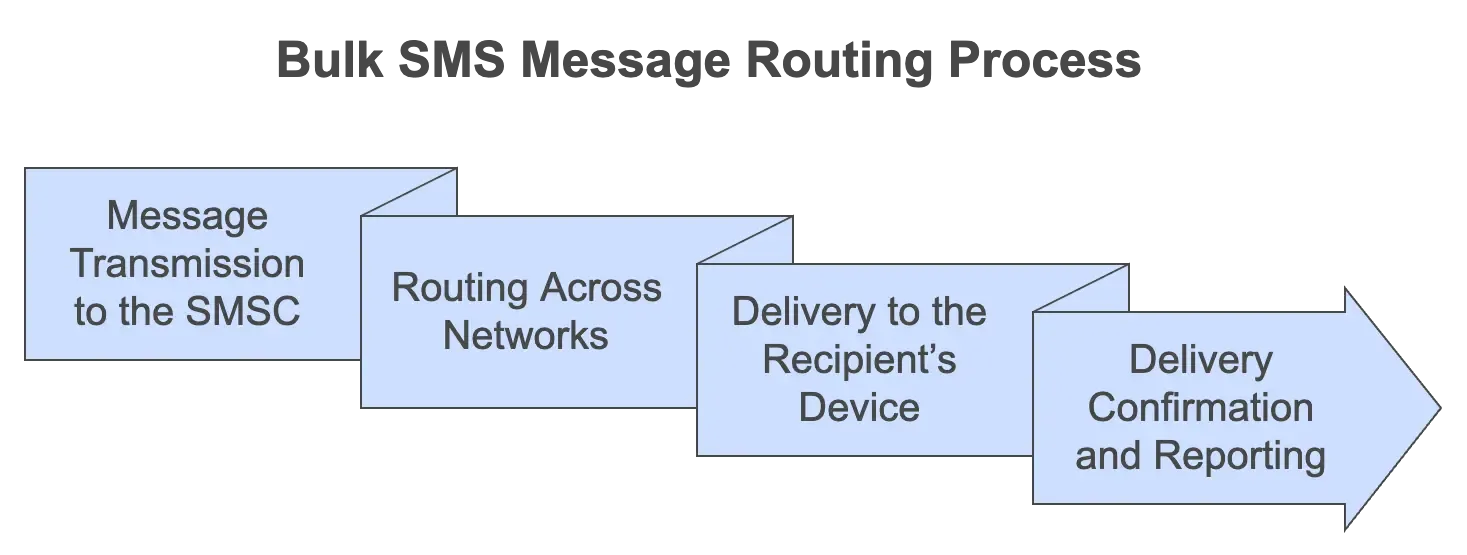
How Bulk SMS Works: An Inside Look at Sending Texts at Scale
Learn how bulk SMS works, from message creation to delivery optimization. Understand the technical steps to boost your business communication.
Abhishek Prakash
•Strategic sales leader with deep focus on customer relationship building and revenue growth. With over two decades of experience at corporates like IBM, Bharti Airtel, and Reliance Jio, driving excellence in enterprise profitability and competitive advantage.
Understanding Bulk SMS: How Mass Texting Works Behind the Scenes
Imagine being able to reach thousands of customers instantly, ensuring that your message lands directly in their hands. In a digital age where timing and reach can make or break a campaign, bulk SMS messaging has become a powerhouse for businesses. But beyond the impressive open rates and high-speed delivery, have you ever wondered how bulk SMS works behind the scenes? If you’re looking to make the most of this tool, understanding the mechanics of bulk SMS isn’t just interesting—it can provide a significant strategic edge.  Knowing how messages are created, routed, and delivered helps businesses fine-tune their approach, making sure each message is crafted for maximum impact and reaches its destination smoothly. By understanding the process from start to finish, you can also optimize your campaigns, troubleshoot issues faster, and ensure better compliance with messaging regulations. If you’re ready to dive into the inner workings of bulk SMS, this guide will take you through each step, shedding light on the technology and processes that bring your messages to life. And once you understand how it all works, you can check out our comprehensive guide on how to send bulk SMS for practical steps to start or enhance your SMS marketing efforts.
Knowing how messages are created, routed, and delivered helps businesses fine-tune their approach, making sure each message is crafted for maximum impact and reaches its destination smoothly. By understanding the process from start to finish, you can also optimize your campaigns, troubleshoot issues faster, and ensure better compliance with messaging regulations. If you’re ready to dive into the inner workings of bulk SMS, this guide will take you through each step, shedding light on the technology and processes that bring your messages to life. And once you understand how it all works, you can check out our comprehensive guide on how to send bulk SMS for practical steps to start or enhance your SMS marketing efforts.
What is Bulk SMS?
Bulk SMS is the process of sending large volumes of text messages to a group of recipients simultaneously. It’s a go-to communication channel for businesses aiming to engage customers instantly, whether for promotions, alerts, reminders, or updates.  With near-instant delivery and high open rates, bulk SMS allows companies to cut through digital noise and reach customers in seconds. But while sending bulk SMS may seem simple, there’s a sophisticated system operating behind each message to ensure it reaches its destination. In the next sections, we’ll dive into the technical side of bulk SMS to reveal what happens from the moment you hit “send” to when your message arrives on a recipient’s phone.
With near-instant delivery and high open rates, bulk SMS allows companies to cut through digital noise and reach customers in seconds. But while sending bulk SMS may seem simple, there’s a sophisticated system operating behind each message to ensure it reaches its destination. In the next sections, we’ll dive into the technical side of bulk SMS to reveal what happens from the moment you hit “send” to when your message arrives on a recipient’s phone.
How Bulk SMS Works: Step-by-Step
Understanding the journey of a bulk SMS message from creation to delivery can give valuable insights into optimizing campaigns and ensuring messages reach the intended recipients smoothly.  Here’s a closer look at each step involved in the bulk SMS process:
Here’s a closer look at each step involved in the bulk SMS process:
1. Message Creation
The first step in any bulk SMS campaign is crafting the message itself. Businesses typically use SMS platforms that allow them to compose messages within a 160-character limit, often incorporating personalization options like the recipient’s name or a specific offer. But this doesn’t mean that you can’t send a message of more than 160 characters, the limitation just means that 1 credit will be utilized for every 160 characters, hence if you want you can send longer messages, it’ll just use credits accordingly. And since SMS is one of the cheapest messaging channels, it hardly matters for businesses like yours. Personalization makes the message feel relevant, which can improve engagement rates. Many platforms also support dynamic fields, enabling marketers to tailor each message based on recipient data for an even more customized experience.
2. Bulk SMS Gateway
Once the message is ready, it’s sent to a bulk SMS gateway, a crucial piece of infrastructure in the messaging chain. The gateway acts as a bridge between the SMS platform and mobile carriers. It receives the message, processes it, and determines the best route to deliver it efficiently. The gateway manages traffic by organizing messages into manageable batches, ensuring high throughput while avoiding network congestion. Essentially, it’s the digital “post office” for SMS, routing each message accurately to its destination.
3. Carrier Aggregation
After the message passes through the gateway, it’s then handed off to a carrier aggregator. Aggregators connect directly with multiple mobile carriers, consolidating messages for efficient delivery. By aggregating messages, they ensure that each message reaches the correct carrier for the recipient’s network. Carrier aggregation helps reduce latency (the time it takes for a message to reach its destination) and minimizes costs by optimizing delivery across different carriers.
4. Delivery Optimization
Several factors affect how quickly and reliably a message is delivered to recipients, including message queuing, throttling, and prioritization:  Message Queuing: When large volumes of messages are sent simultaneously, they’re queued to prevent overloading the system and ensure each message is sent in order. Throttling: This technique controls the flow rate of messages sent per second to avoid network congestion, which could delay message delivery. Prioritization: Some messages, like time-sensitive alerts, are given priority to ensure they reach recipients faster, while non-urgent messages may be sent with a lower priority. These delivery optimization tactics ensure that messages reach recipients at the right time, maximizing engagement and reducing failed deliveries.
Message Queuing: When large volumes of messages are sent simultaneously, they’re queued to prevent overloading the system and ensure each message is sent in order. Throttling: This technique controls the flow rate of messages sent per second to avoid network congestion, which could delay message delivery. Prioritization: Some messages, like time-sensitive alerts, are given priority to ensure they reach recipients faster, while non-urgent messages may be sent with a lower priority. These delivery optimization tactics ensure that messages reach recipients at the right time, maximizing engagement and reducing failed deliveries.
5. Sender ID Management
To enhance recognition and trust, businesses can set up a custom Sender ID—usually the business name or a short code. The Sender ID acts as a “from” label, showing recipients who the message is from before they even open it. In many countries, custom Sender IDs and short codes require registration and approval to prevent misuse and reduce spam. This process safeguards recipients and ensures only approved, identifiable IDs are used, improving message credibility.
How Bulk SMS Messages Are Routed to Recipients
Once a bulk SMS message is created, approved, and optimized for delivery, it begins its journey through a technical routing system to reach each recipient. This process involves a key component called the Short Message Service Center (SMSC), which handles the routing and management of SMS messages across networks.  Here’s how the routing path works:
Here’s how the routing path works:
1. Message Transmission to the SMSC
After the message is processed by the SMS gateway, it’s passed along to an SMSC. The SMSC acts as the central hub for managing SMS traffic, ensuring that each message is correctly routed based on the recipient’s mobile carrier and location. In cases where a message cannot be delivered immediately (e.g., the recipient’s phone is off or out of range), the SMSC will store the message temporarily until it’s ready to be sent.
2. Routing Across Networks
Once the SMSC identifies the recipient’s carrier network, it forwards the message accordingly. This step is crucial for routing messages to recipients on different networks and in different regions, especially when messages are sent internationally. The SMSC uses specific protocols (such as SMPP, or Short Message Peer-to-Peer) to communicate with other carrier networks, ensuring that the message is relayed seamlessly.
3. Delivery to the Recipient’s Device
When the message reaches the recipient’s carrier network, it is then sent to the end user’s mobile device. The carrier handles the final leg of delivery, which typically happens within seconds, ensuring that the message appears promptly in the recipient’s SMS inbox. If a message encounters delays due to network congestion, the SMSC may attempt re-routing or queuing to deliver the message as soon as possible.
4. Delivery Confirmation and Reporting
Once the message reaches the recipient’s device, a delivery receipt is sent back through the same path to the SMS gateway or platform. This receipt provides crucial data on delivery status, indicating whether the message was successfully delivered, delayed, or failed. Delivery reporting helps businesses track the effectiveness of their bulk SMS campaigns, allowing them to troubleshoot and refine their approach as needed. By passing through SMSCs and carrier networks, bulk SMS messages navigate a well-established routing path designed to optimize speed, reliability, and reach, ensuring that each message is delivered accurately and efficiently.
Factors Affecting Bulk SMS Delivery
While bulk SMS is a fast and reliable channel for reaching customers, several factors can impact whether and how quickly messages are delivered.  Understanding these factors can help businesses optimize their SMS campaigns and avoid common pitfalls.
Understanding these factors can help businesses optimize their SMS campaigns and avoid common pitfalls.
1. Carrier-Level Filtering
Carriers play a significant role in SMS delivery by filtering messages to ensure compliance with regulations and prevent spam. To protect users from unsolicited messages, carriers often use filtering algorithms to detect and block messages that appear suspicious. Messages may be filtered out if they:
- Don’t comply with local regulations or industry standards.
- Contain keywords often associated with spam or fraudulent activity.
- Use unauthorized Sender IDs or short codes.
To avoid carrier filtering, businesses should ensure they have permission from recipients to send messages, register Sender IDs where required, and follow best practices for message content and frequency.
2. Network Availability
Network conditions can also affect the speed and success of SMS delivery. Factors such as peak usage times, network congestion, and signal strength can create delays, especially if recipients are in remote areas or have limited connectivity. During high-traffic periods (e.g., holidays or major events), messages may be queued by carriers, which can slow down delivery times. To mitigate this, businesses can time their campaigns strategically, avoiding peak hours whenever possible.
3. Message Content
The content of a message can also influence its delivery: Links and Keywords: Certain keywords or URLs may trigger carrier filters, especially if they’re linked to promotional or unsolicited content. To reduce the risk of filtering, avoid overly promotional language and use shortened, reputable URLs. Special Characters and Emojis: While adding symbols or emojis can personalize a message, these elements may cause encoding issues or increase the message length. In some cases, they can cause messages to be split into multiple parts, increasing costs and potentially slowing down delivery. Ensuring that content is concise, relevant, and compliant with carrier policies can significantly improve delivery rates and ensure messages reach recipients effectively.
Tracking and Reporting
Tracking and reporting are essential components of any successful bulk SMS campaign. With the right tools and metrics, businesses can monitor their SMS performance in real time, gain insights into audience behavior, and fine-tune strategies for better results. Here’s a look at the key features of SMS tracking and reporting:
1. Delivery Reports
 One of the most fundamental metrics for any SMS campaign is the delivery rate. Delivery reports provide detailed information on whether your messages were successfully delivered to the recipients’ devices. These reports often include: Successful Deliveries: The number of messages that were successfully received by recipients. Failures or Bounces: Indicates the messages that couldn’t be delivered, including reasons like invalid numbers, network issues, or carrier filtering. Pending Messages: Messages that were queued but not yet delivered due to factors like network congestion or recipient unavailability. By reviewing these reports, businesses can identify delivery issues, refine their recipient lists, and ensure that future campaigns are optimized for better reach.
One of the most fundamental metrics for any SMS campaign is the delivery rate. Delivery reports provide detailed information on whether your messages were successfully delivered to the recipients’ devices. These reports often include: Successful Deliveries: The number of messages that were successfully received by recipients. Failures or Bounces: Indicates the messages that couldn’t be delivered, including reasons like invalid numbers, network issues, or carrier filtering. Pending Messages: Messages that were queued but not yet delivered due to factors like network congestion or recipient unavailability. By reviewing these reports, businesses can identify delivery issues, refine their recipient lists, and ensure that future campaigns are optimized for better reach.
2. Open Rates
 SMS boasts some of the highest open rates in the marketing world, with many messages being read within minutes of delivery. While SMS doesn’t have a built-in “open” tracking like email does (due to privacy restrictions), some advanced platforms can track actions like clicking on links or engaging with the message content. If your campaign includes a Call to Action (CTA) like “Click here” or a URL, tracking how many recipients engage with the link can give a good indication of how many people interacted with the message.
SMS boasts some of the highest open rates in the marketing world, with many messages being read within minutes of delivery. While SMS doesn’t have a built-in “open” tracking like email does (due to privacy restrictions), some advanced platforms can track actions like clicking on links or engaging with the message content. If your campaign includes a Call to Action (CTA) like “Click here” or a URL, tracking how many recipients engage with the link can give a good indication of how many people interacted with the message.
3. Engagement Metrics
 Engagement metrics go beyond simple delivery to provide deeper insights into how recipients respond to your messages. These may include: Click-Through Rate (CTR): Measures the number of recipients who clicked on links or responded to the CTA in your message. Conversion Rate: Tracks how many recipients took the desired action (e.g., making a purchase, signing up, or completing a survey) after receiving the SMS. Response Rate: In campaigns where two-way interaction is enabled (such as surveys or customer support), this metric tracks how many people replied to your SMS. These metrics allow businesses to assess the effectiveness of their campaigns, identify which messages resonate with their audience, and optimize future content and targeting strategies.
Engagement metrics go beyond simple delivery to provide deeper insights into how recipients respond to your messages. These may include: Click-Through Rate (CTR): Measures the number of recipients who clicked on links or responded to the CTA in your message. Conversion Rate: Tracks how many recipients took the desired action (e.g., making a purchase, signing up, or completing a survey) after receiving the SMS. Response Rate: In campaigns where two-way interaction is enabled (such as surveys or customer support), this metric tracks how many people replied to your SMS. These metrics allow businesses to assess the effectiveness of their campaigns, identify which messages resonate with their audience, and optimize future content and targeting strategies.
4. Analyzing and Refining Strategies
 The true power of tracking and reporting lies in how businesses use the data to refine their SMS strategies. By analyzing metrics like delivery rates, CTR, and conversion rates, businesses can: Optimize Messaging Content: Identify which messages or CTAs performed best and replicate successful formats in future campaigns. Segment Audiences More Effectively: Use data to create more targeted campaigns based on user behavior and preferences. Time Campaigns for Maximum Impact: By tracking when messages are most likely to be delivered successfully, businesses can better time their messages for optimal engagement. Test and Iterate: With A/B testing capabilities, businesses can test different messaging formats, sender IDs, or times of day to see what generates the best results. Incorporating these insights into your strategy will help improve future campaigns, increase engagement, and ultimately drive higher ROI from bulk SMS marketing.
The true power of tracking and reporting lies in how businesses use the data to refine their SMS strategies. By analyzing metrics like delivery rates, CTR, and conversion rates, businesses can: Optimize Messaging Content: Identify which messages or CTAs performed best and replicate successful formats in future campaigns. Segment Audiences More Effectively: Use data to create more targeted campaigns based on user behavior and preferences. Time Campaigns for Maximum Impact: By tracking when messages are most likely to be delivered successfully, businesses can better time their messages for optimal engagement. Test and Iterate: With A/B testing capabilities, businesses can test different messaging formats, sender IDs, or times of day to see what generates the best results. Incorporating these insights into your strategy will help improve future campaigns, increase engagement, and ultimately drive higher ROI from bulk SMS marketing.
Choosing the Right Bulk SMS Provider
Selecting the right bulk SMS provider is crucial for ensuring smooth and effective communication with your audience. A reliable provider can help you achieve high delivery rates, timely message dispatch, and access to advanced features that will enhance your SMS campaigns. Here are the key factors to consider when choosing a bulk SMS provider: 
1. Reliability and Uptime
The reliability of your SMS provider is paramount. You need a provider that guarantees high uptime and can handle large volumes of messages without delays. Look for a provider with a track record of consistent delivery performance and minimal downtime, especially during peak traffic periods.
2. Global Reach
If your business operates internationally or has a global customer base, it’s essential to choose a provider with extensive carrier coverage. A provider with global reach can help you send messages to customers in different countries, ensuring that your campaigns have a wider impact. Verify that the provider supports international SMS delivery and has connections with multiple carriers to avoid any potential bottlenecks.
3. Support and Customer Service
Access to 24/7 customer support is vital for addressing any technical issues or campaign-related inquiries. Choose a provider that offers round-the-clock support, ideally through multiple channels like live chat, email, and phone. A provider with a dedicated support team will ensure that you can quickly resolve any challenges and keep your campaigns running smoothly.
4. Easy Integration and API Access
Your bulk SMS provider should offer seamless integration with your existing systems, whether it’s your CRM, marketing platform, or customer service tools. An intuitive API will enable your team to automate processes, track campaigns, and manage your messages more efficiently. Make sure the provider offers easy-to-use tools and guides for integration.
5. Pricing and Flexibility
Pricing can vary significantly across bulk SMS providers, so it’s important to choose one that offers competitive rates without compromising on service quality. Look for flexible pricing models based on your message volume, with options that allow you to scale as your business grows. Some providers offer volume discounts, while others may charge per SMS or based on your subscription plan.
6. Advanced Features and Analytics
To make the most of your bulk SMS campaigns, choose a provider that offers advanced features like message scheduling, campaign analytics, two-way messaging, and automated responses. Robust analytics will help you monitor delivery rates, engagement, and conversion metrics, so you can refine your strategy for optimal results. By considering these factors, you can ensure that you’re working with a bulk SMS provider that aligns with your business needs and can help you achieve your communication goals.
Conclusion
Understanding how bulk SMS works is the first step in harnessing its full potential for your business. By diving into the technical aspects—from message creation to delivery optimization—you can ensure that your campaigns are well-structured, effective, and capable of driving real results.  When you grasp the mechanics behind bulk SMS, you’ll be better equipped to refine your strategies, enhance customer engagement, and improve your ROI. Now that you have a foundational understanding of how bulk SMS works, it’s time to take it to the next level. For a step-by-step guide on how to implement a successful bulk SMS strategy, including practical tips on setting up your campaigns, choosing a provider, and optimizing your efforts, explore our How to Send Bulk SMS: A Complete Guide for more in-depth insights. In case you want to consult with our experts directly, please book a free strategic consultation.
When you grasp the mechanics behind bulk SMS, you’ll be better equipped to refine your strategies, enhance customer engagement, and improve your ROI. Now that you have a foundational understanding of how bulk SMS works, it’s time to take it to the next level. For a step-by-step guide on how to implement a successful bulk SMS strategy, including practical tips on setting up your campaigns, choosing a provider, and optimizing your efforts, explore our How to Send Bulk SMS: A Complete Guide for more in-depth insights. In case you want to consult with our experts directly, please book a free strategic consultation.